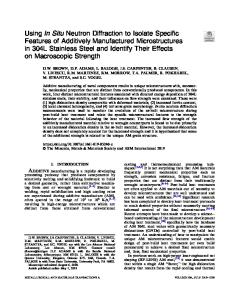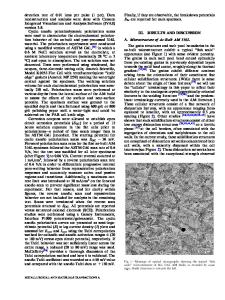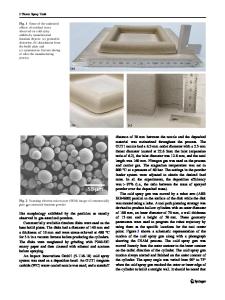Additively manufactured copper matrix composites: Heterogeneous microstructures and combined strengthening effects
- PDF / 1,558,696 Bytes
- 9 Pages / 584.957 x 782.986 pts Page_size
- 112 Downloads / 279 Views
FOCUS ISSUE
ADDITIVE MANUFACTURING OF METALS: COMPLEX MICROSTRUCTURES AND ARCHITECTURE DESIGN
Additively manufactured copper matrix composites: Heterogeneous microstructures and combined strengthening effects Heng Ouyang1, Ge Wang1, Zan Li1,a), Qiang Guo1,b) 1
State Key Laboratory of Metal Matrix Composites, Shanghai Jiao Tong University, Shanghai 200240, China Address all correspondence to these authors. e-mail: [email protected] b) e-mail: [email protected] a)
Received: 31 December 2019; accepted: 28 February 2020
We here design and fabricate a new kind of copper matrix composites, where titanium carbide nanoparticles are in situ incorporated into and embedded within the copper matrix, by virtue of laser powder-bed-fusion (LPBF) process. We made a multiscale examination on the microstructures of the additively manufactured samples, unraveling that there are many unusual microstructural features, including grain refinement, the existence of high-density dislocations, and supersaturation of titanium solute atoms in the as-printed metal matrix composites. These unique microstructural features are mainly interpreted by the intense thermal history and the rapid solidification nature of the L-PBF process. The resultant composites then integrate the most important four strengthening mechanisms in metals: grain boundary strengthening, dislocation strengthening, solid solution strengthening, and second-phase strengthening, rendering this new kind of copper matrix composites a remarkably high yield strength (;490 MPa) and large uniform elongation (;12%), surpassing many high-performance copper matrix composites and copper alloys.
Introduction The use of metals and alloys is determined and limited by their inherent attributes (e.g., elastic modulus and electrical conductivity). Forming metal matrix composites (MMCs) by combining another nonmetallic phase into the metal matrix may lead to superior specific performances that well exceed the property boundaries of conventional metals/alloys [1, 2, 3]. Nonetheless, the mechanical property enhancement of MMCs may not be as remarkable as expected, owing to many “extrinsic” factors, such as the weak bonding and elevated stress concentration characteristic of the reinforcement/matrix interfaces [4], in addition to the limitations rendered by the “intrinsic” factors, i.e., the various operating strengthening and deformation mechanisms of the composite. The design principle of high-strength MMCs relies on the introduction and optimization of reinforcement-correlated strengthening mechanisms. In this context, in the past few years, efforts have been devoted to achieving multiple strengthening mechanisms through tailoring the morphology and distribution of the reinforcements [4]. Some recently developed
ª Materials Research Society 2020
fabrication strategies, e.g., molecular-level mixing and flake powder metallurgy, have yielded a wealth of novel nanophasereinforced MMCs with excellent mechanical properties [5, 6, 7]. For instance, grapheme-reinforced MMCs with a bioinspired nan
Data Loading...











